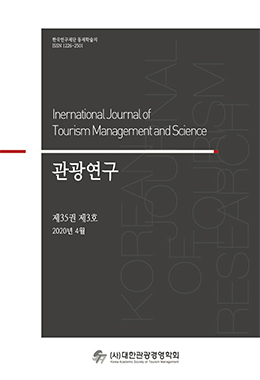관광동기의 가장 중요한 요인 가운데 하나는 관광욕구이며, 이러한 욕구는 잠재 관광객들의 감정에 영향을 미친다는 측면에서 코로나19 확산으로 인해 관광객들의 억제되어 있는 관광욕구가 어떠한 감정으로 표출될 수 있는지 파악해볼 필요가 있다. 이에, 본 연구에서는 코로나19 상황에서 관광욕구를 가진 잠재 관광객들의 감정 반응을 파악하기 위해 의미론적 네트워크 분석을 활용해 코로나 확산과 관광/여행에 대한 트위터 공유 내용을 살펴보고 이를 토대로 관광산업의 대응 방안을 제시하고자 하였다. 국내 잠재 관광객들의 코로나와 관광/여행에 대한 감정을 분석하기 위하여 코로나19 확산으로 171개국에서 한국인 입국금지를 시행한 시점인 2020년 3월 9일부터 25일까지 트위터(Twitter)에 공유한 내용을 데이터 수집의 대상으로 삼았다. 한국어 ‘코로나 관광’과 ‘코로나 여행’을 키워드로 삼았으며, ‘코로나 관광’으로 2,126개, ‘코로나 여행’으로 8,278개의 트윗이 수집되었으며, 트윗을 다시 공유한 리트윗 결과들은 모두 제외하여 총 1,905개 트윗과 멘션을 분석에 활용하였고, 단어 간 연결 관계를 파악해 네트워크화 시키는 분석법인 의미론적 네트워크 분석(semantic network analysis, SNA)을 활용하여 연구 결과를 도출하였다. 연구 결과에 따르면, 네 가지 주요 군집을 도출해냈으며, ‘군집 1) 놀라움: 여행 후 감염 뉴스,’ ‘군집 2) 억눌림: 강한 여행 욕구,’ ‘군집 3) 불안: 여행 경보와 관광업계 경영난,’ 그리고 ‘군집 4) 분노: 입국금지에 대한 반응’으로 명명했다. 전염병 확산에 대한 잠재 관광객의 감정 반응에 대한 연구는 전무한 실정으로서, 본 연구는 잠재 관광객들이 공유한 텍스트를 통해 직접적으로 감정적 반응을 읽어내려고 시도했다는 점에서 그 가치가 있다.
One of the most important factor in tourism motivation is the desire for tourism, and it is necessary to find out how the COVID-19 spread has an influence on the potential tourists' emotions, especially for the pent-up travel desire. This study wanted to examine the contents of Twitter sharing on the spread of COVID-19(Corona19) and tourism/travel by using semantic network analysis. Also, this study suggested countermeasures for the tourism industry based on the results. In order to analyze the emotional responses of Korean potential tourists on COVID-19 and tourism/travel, the data collection target was tweets and mentions on Twitter from March 9-25, 2020, when the COVID-19 forced the entry bans on Koreans from 171 countries. Keywords were 'Corona Tour' and 'Corona Travel' in Korean, 2,126 tweets were collected as 'Corona Tour' and 8,278 tweets were collected as 'Corona Travel'. In total of 1,905 tweets were used for the data analysis after excluding all retweets. This study used semantics network analysis to identify connection between words. According to the study, four major clusters were derived: Cluster 1) Surprise: Post-Travel Infection News; Cluster 2) Suppression: Strong Travel Needs: Cluster 3) Anxiety: Travel Alerts and Financial Difficulties of Tourism Industry; and Cluster 4) Rage: Reaction to Entry Bans. The study has value because it attempted to read out Korean potential tourists’ emotional responses towards the spread of COVID-19 directly through shared text.


